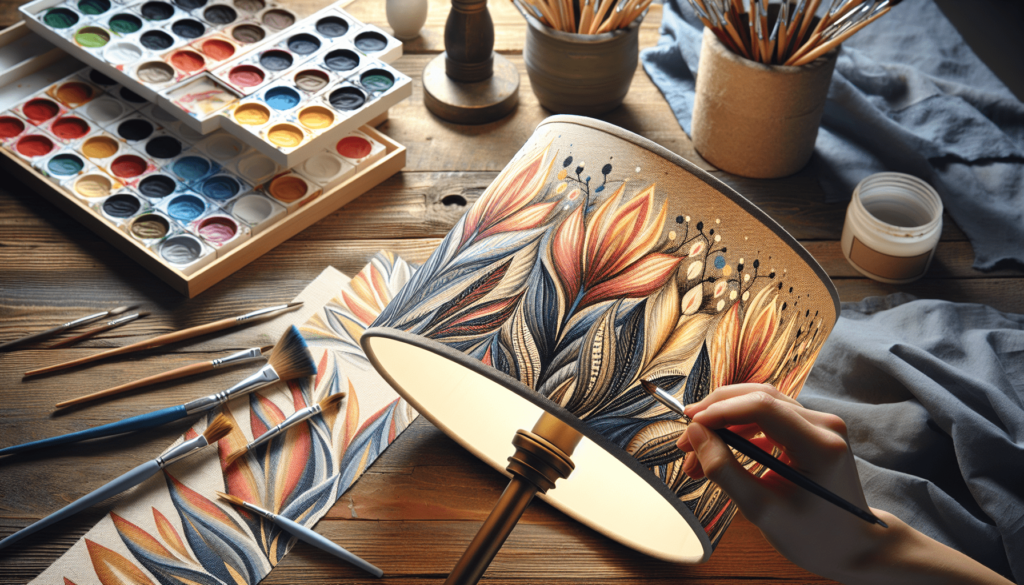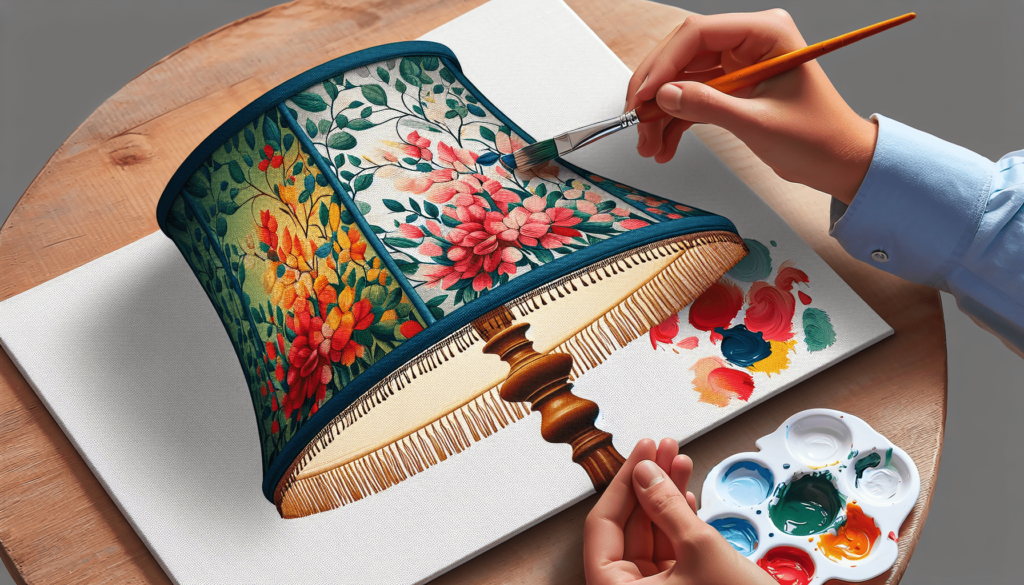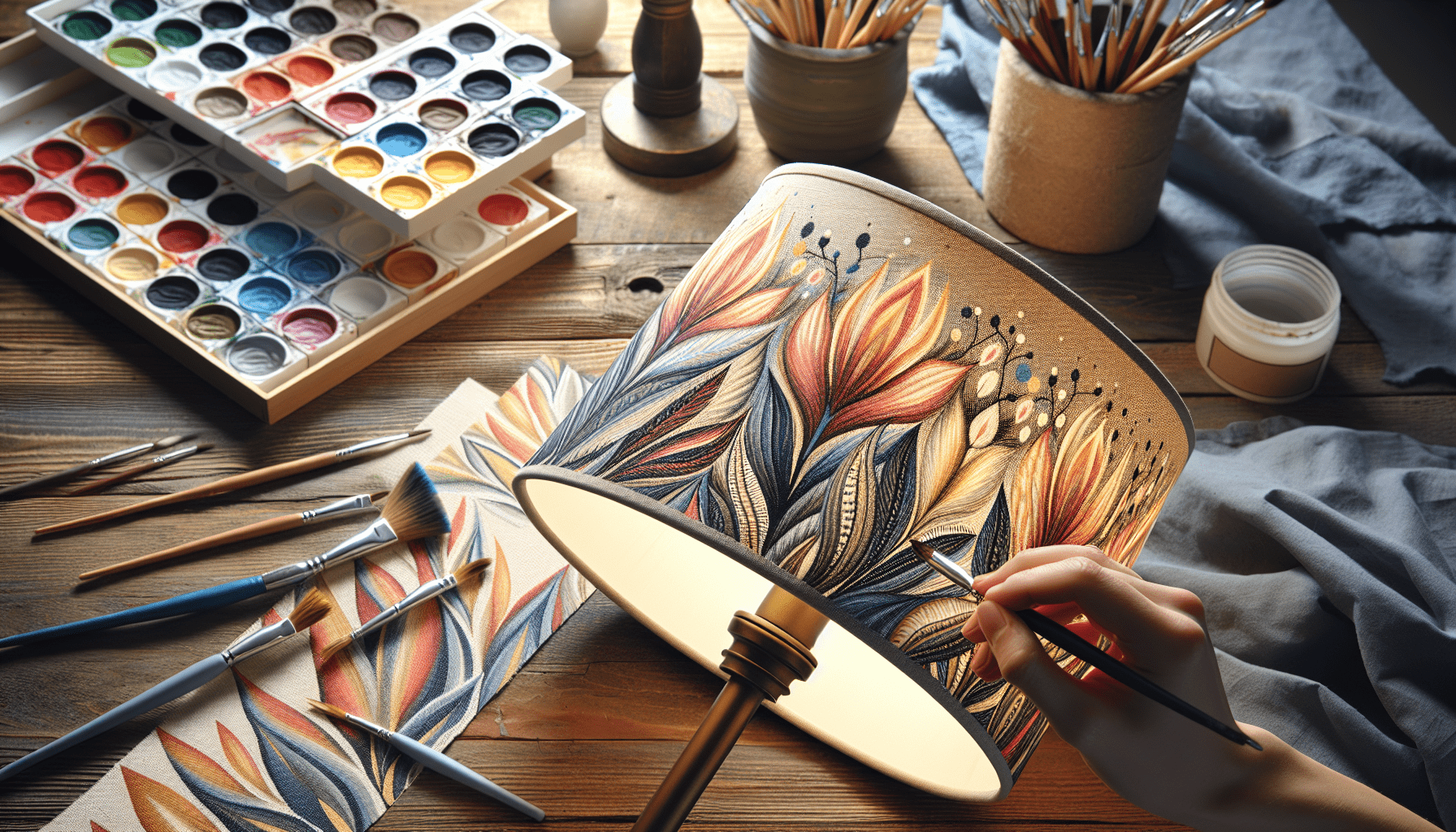In this article, you will explore the possibility of transforming a fabric lamp shade through the art of painting. While many may question the feasibility of such a project, the idea of breathing new life into an old or plain lamp shade through the stroke of a paintbrush holds undeniable appeal. By understanding the appropriate techniques and materials, you can not only elevate the aesthetic of your space but also unleash your creativity onto a seemingly mundane object. So, can you paint a fabric lamp shade? Let us unravel the possibilities together.
Preparing the Lamp Shade
Clean the lamp shade
Before starting the painting process, it is crucial to clean the lamp shade thoroughly. Use a mild detergent or fabric cleaner to remove any dust, dirt, or stains that may be present on the surface. Gently scrub the shade with a soft cloth or sponge, taking care not to damage the fabric. Rinse the shade with water and allow it to dry completely before proceeding to the next step. This ensures that the paint adheres well to the surface and provides a smooth and even finish.
Sand the surface
Sanding the lamp shade is an important step to create a better bonding surface for the paint. Gently sand the fabric using fine-grit sandpaper, making sure to cover the entire surface. This step helps in removing any roughness or imperfections, allowing the paint to adhere more effectively. Avoid applying too much pressure while sanding to prevent damaging the fabric. Once you have finished sanding, use a clean cloth to remove any dust or debris resulting from the sanding process.
Protect the surroundings
Painting a lamp shade can be a messy process, so it is essential to take precautions to protect the surrounding area from paint splatters or spills. Place a drop cloth or plastic sheet underneath the lampshade to catch any paint drips. It is also advisable to cover nearby furniture, flooring, or any other delicate items that may be at risk of being stained by the paint. By taking these preventive measures, you can ensure a clean and hassle-free painting experience.
Choosing the Right Paint
Consider fabric type
When selecting the paint for your fabric lamp shade, it is important to consider the type of fabric it is made of. Different fabrics react differently to various types of paint, so it is essential to choose a paint that is suitable for the specific fabric material. For example, acrylic paint works well on most fabrics, including cotton, polyester, and linen. On the other hand, oil-based paints are more suited for heavy-duty and natural fabrics such as canvas or denim. Research the fabric type of your lampshade and consult with a salesperson or expert at your local arts and crafts store to ensure you choose the appropriate paint.
Select appropriate paint type
Once you have determined the fabric type, it is time to select the appropriate paint type. There are various options available in the market, including fabric paints, fabric dyes, and acrylic paints. Fabric paints are specifically designed for use on fabrics and offer excellent adhesion and flexibility. Fabric dyes, on the other hand, are absorbed by the fabric fibers and provide a more permanent color. Acrylic paints can also be used, especially if you want a wide range of color options. Consider the desired outcome and the specific characteristics of each paint type before making your final decision.
Test the paint
Before applying the paint directly onto the lamp shade, it is advisable to test it on a small, inconspicuous area of the fabric. This allows you to assess how the paint adheres to the fabric and how the color appears once dry. Apply a small amount of the paint and observe the results. Pay attention to factors such as color vibrancy, texture, and drying time. Testing the paint beforehand ensures that you are satisfied with the outcome and gives you an opportunity to make any necessary adjustments before committing to painting the entire lamp shade.

Preparing the Paint
Mix the paint
In some cases, you may need to mix different colors of paint to achieve the desired shade. Before starting the painting process, carefully measure and mix the paint according to the instructions provided on the paint containers. Use a palette or a clean container to mix the colors, ensuring that they are thoroughly combined. Mixing the paint beforehand helps to ensure consistency of color throughout the lamp shade and prevents any variations or blotches that may occur if you were to mix the colors directly on the fabric.
Add fabric medium
Adding a fabric medium to your paint is highly recommended as it helps to improve the durability and flexibility of the painted surface. Fabric medium acts as a bonding agent between the paint and fabric, ensuring better adhesion and preventing cracking or peeling. Follow the instructions on the fabric medium packaging to determine the appropriate mixing ratio with the paint. Typically, fabric medium is mixed with the paint in equal parts. Incorporate the fabric medium into the paint mixture and stir well to ensure that it is evenly distributed.
Stir thoroughly
Once you have mixed the paint and fabric medium, make sure to stir the mixture thoroughly. Use a stir stick or a clean paintbrush to mix the contents of the container, ensuring that no lumps or clumps are present. Stirring the paint mixture well helps to ensure that the fabric medium is evenly distributed, providing consistent coverage and preventing any separation or streaks when applied to the lamp shade. A thoroughly stirred paint mixture will also ensure that the pigments are properly dispersed, resulting in a more vibrant and uniform color on the fabric.
Applying the Paint
Start with a primer
Before applying the paint onto the fabric lamp shade, it is recommended to use a fabric primer. The primer helps to create an even and smooth surface for the paint to adhere to, ensuring better color payoff and longevity. Applying a thin layer of fabric primer also helps to prevent the fabric from absorbing too much paint, which can lead to a dull or uneven finish. Follow the instructions on the primer packaging to apply it evenly to the entire lamp shade surface. Allow the primer to dry completely before proceeding with the paint application.
Apply thin coats
When it comes to applying the paint on the lamp shade, it is best to work in thin, even coats. Applying multiple thin coats of paint allows for better control over the color intensity and helps to prevent the fabric from becoming stiff or heavy. Use a clean, soft paintbrush or a foam brush for application, ensuring smooth and even strokes. Avoid saturating the fabric with too much paint at once, as this can lead to drips, uneven coverage, or prolonged drying time. Instead, build up the color gradually by applying subsequent thin coats once the previous one has dried completely.
Allow drying time
After each coat of paint, allow sufficient drying time before applying the next layer or handle the lamp shade. Drying time may vary depending on the type of paint used and the environmental conditions. It is crucial to follow the instructions provided by the paint manufacturer to ensure proper drying. Rushing the drying process can result in smudging or smearing of the paint, ruining the final finish. Additionally, allowing each coat to dry thoroughly ensures that the subsequent layer adheres well and minimizes the risk of the paint cracking or peeling over time.

Adding Design or Patterns
Use stencils
If you want to add intricate designs or patterns to your fabric lamp shade, stencils can be an excellent tool to achieve precise and consistent results. Stencils are available in various designs and sizes, allowing you to choose the one that best suits your aesthetic preferences. Secure the stencil onto the lamp shade using painter’s tape or adhesive spray. Dip a stencil brush or a sponge brush into the paint and tap off any excess. Gently dab the brush over the stencil, being careful not to smudge or move it. This technique helps to create clean and crisp designs on the fabric.
Create freehand designs
For those who prefer a more artistic approach, creating freehand designs on the fabric lamp shade can be a fulfilling and creative experience. Use a paintbrush or fabric markers to draw or paint directly onto the fabric, allowing your imagination to guide you. Sketch your desired design lightly with a pencil before applying the paint to ensure accuracy and precision. Remember to take your time and have a steady hand to achieve the desired results. This method allows for customization and uniqueness, as you can create one-of-a-kind designs that reflect your personal style.
Experiment with different techniques
Painting a fabric lamp shade provides an opportunity to explore and experiment with various painting techniques. Consider techniques such as sponge painting, splatter painting, or even using unconventional tools like toothbrushes or sponges to create interesting textures and effects. Don’t be afraid to try new techniques and mix different colors to achieve captivating and visually appealing designs. Experimenting with techniques can not only add depth and dimension to the lamp shade but also make it a true work of art that enhances the overall aesthetic of your space.
Fixing Mistakes
Remove excess paint
In case of any mistakes or excess paint, it is crucial to address them promptly. If there are any paint drips or smudges, gently blot the affected area with a clean paper towel or cloth to absorb the excess paint. Avoid rubbing or scrubbing, as this can spread the paint further and potentially damage the fabric. For larger mistakes, you may need to use a damp cloth or sponge to carefully lift away the paint. Promptly attending to mistakes helps to maintain the overall integrity of the design and prevents any unwanted marks or smears from detracting from the finished lamp shade.
Cover mistakes with additional paint
If the mistake is minor and cannot be entirely removed, consider covering it up with additional paint. Use a small paintbrush or a fabric marker in a matching color to carefully touch up the mistake, blending it seamlessly with the surrounding area. Depending on the complexity of the design and the size of the mistake, this method can effectively camouflage any flaws and maintain the overall visual appeal of the lamp shade. Remember to let the touched-up area dry completely before adding additional coats of paint or handling the lamp shade.
Consider fabric markers or pens
In some cases, fabric markers or pens can be a useful tool to fix or enhance the design on the lamp shade. Fabric markers are available in a range of colors and tip sizes, allowing for precision and control. If you have made a mistake or want to add finer details to the design, fabric markers can provide a quick and convenient solution. Additionally, fabric markers can also be used to create intricate patterns or outlines that complement the overall design. Make sure to follow the instructions provided with the fabric markers and test them on a small area before applying them to the entire lamp shade.
Finishing Touches
Seal the paint
To protect the painted surface and extend the longevity of the design, it is advisable to seal the paint with a fabric sealant or clear varnish. Fabric sealants provide an additional layer of protection against wear, stains, and fading. Apply the fabric sealant according to the manufacturer’s instructions, ensuring even coverage over the entire lamp shade. This step helps to preserve the vibrancy of the colors and keeps the paint from rubbing off or smudging over time. Once the sealant has dried, your painted lamp shade will be more resistant to daily wear and tear and will maintain its visual appeal for a longer duration.
Add embellishments
Consider adding embellishments to further enhance the design of your painted lamp shade. This could include attaching decorative trims, beads, or fabric flowers using fabric glue or small stitches. Embellishments can add an extra dimension and create a focal point on the lamp shade. Choose items that complement the color scheme and overall aesthetic of the design, ensuring a cohesive and visually appealing final result. However, be mindful not to overcrowd the lamp shade with too many embellishments, as it may detract from the elegance and simplicity of the painted design.
Protect the lamp shade
After completing the painting and finishing process, it is essential to take steps to protect the lamp shade from potential damage. Avoid placing the lamp shade in direct sunlight for extended periods as this can cause the colors to fade over time. Likewise, keep the lamp shade away from excessive heat sources to prevent the paint from melting or warping. Handle the lamp shade with care and avoid excessive touching, especially with dirty or greasy hands. By taking these precautions, you can ensure that your painted lamp shade remains intact and retains its beauty for years to come.
Caring for a Painted Lamp Shade
Dust the shade regularly
To maintain the cleanliness and appearance of your painted lamp shade, it is important to dust it regularly. Use a soft, lint-free cloth or a feather duster to gently remove any accumulated dust or debris from the surface. Avoid using abrasive materials or harsh cleaning solutions, as they can damage the paint or fabric. Regular dusting helps to prevent the buildup of dirt and maintains the vibrancy of the colors, ensuring that your painted lamp shade continues to look fresh and appealing.
Avoid excessive handling
While enjoying the beauty of your painted lamp shade, it is important to avoid excessive handling. Excessive handling can cause the paint to rub off or wear down over time, diminishing the overall visual appeal of the design. When adjusting the lamp or cleaning the surrounding area, be mindful not to touch the painted surface unnecessarily. By minimizing handling, you can preserve the integrity of the design and maintain the longevity of the painted lamp shade.
Spot-clean carefully
In the event of any spills or stains on the painted lamp shade, it is crucial to spot-clean the affected area promptly. Use a clean, damp cloth or sponge and gently blot the stained area. It is crucial not to rub or scrub aggressively, as this can damage the paint or fabric. If necessary, use a mild soap or fabric cleaner specifically formulated for delicate fabrics. Test any cleaning products on a small, inconspicuous area of the lamp shade before applying them to the stained area. After spot-cleaning, allow the area to air dry completely before using the lamp shade.
Inspiration and Ideas
Explore different color schemes
Painting a fabric lamp shade offers endless possibilities when it comes to color selection. Explore different color schemes that complement your existing home decor or create a contrasting focal point. Consider the ambiance you want to create in the room and choose colors that align with that vision. Experiment with monochromatic schemes for a sleek and minimalist look or play with bold and vibrant colors for a lively and energetic atmosphere. Be inspired by your personal style and let your creativity guide you as you transform a plain lamp shade into a stylish and eye-catching piece.
Experiment with ombre effects
Ombre effects can add depth and visual interest to a painted lamp shade. Experiment with blending and transitioning colors from light to dark or vice versa. Begin by selecting a color palette that includes shades of the same color, starting with the lightest at the top or bottom of the lamp shade and gradually transitioning to the darkest. Use a sponge or a brush to create smooth and gradual color blends, ensuring a seamless ombre effect. This technique can create a stunning and sophisticated look, adding a touch of elegance and dimension to your painted lamp shade.
Create a personalized design
One of the advantages of painting a fabric lamp shade is the ability to create a personalized design that reflects your individuality and style. Consider incorporating meaningful symbols, patterns, or motifs into your design. You can paint your favorite quotes, images, or even symbols that hold personal significance. By infusing your lamp shade with elements that resonate with you, you can transform it into a truly unique and cherished piece. Let your imagination run wild and experiment with different themes and concepts to create a lamp shade that perfectly represents your personality and adds a personal touch to your living space.
Considerations and Limitations
Limited color options for dark fabric
While painting a fabric lamp shade offers an array of color choices, it is important to note that achieving vibrant or light colors on dark or heavily patterned fabric can be challenging. Dark fabrics may require multiple coats of paint to achieve the desired color intensity, which can affect the texture and flexibility of the fabric. It is advisable to choose lighter or neutral-colored lamp shades if you prefer brighter or pastel hues. Additionally, consider using fabric dyes instead of paint for dark fabrics, as they tend to offer better color saturation and coverage.
Possible texture or stiffness after painting
Painting a fabric lamp shade can alter its texture and make it feel slightly stiffer. This is particularly true when using acrylic paints or fabric paints, which can leave a thin layer of paint on the fabric surface. While fabric medium helps to improve the flexibility of the painted fabric, there may still be a slight change in texture. It is important to consider this possibility and decide if the resulting texture aligns with your expectations and preferences. If you prefer a softer and more pliable lamp shade, consider using fabric dyes instead, as they are designed to penetrate the fabric fibers without altering their texture.
Potential for paint to crack or peel
Over time, it is possible for the paint on a fabric lamp shade to crack or peel, especially if the correct preparation and sealing techniques are not followed. To minimize the risk of paint cracking or peeling, ensure that the lamp shade is properly cleaned and sanded before painting. Apply the paint in thin, even coats and allow each coat to dry completely before proceeding with the next one. Seal the painted surface with a fabric sealant or clear varnish to provide a protective layer. It is crucial to handle the lamp shade with care and avoid excessive handling, as rough handling can lead to the paint becoming damaged or dislodged.



